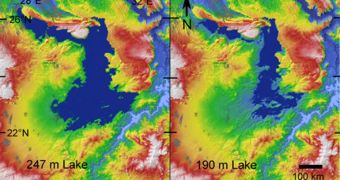According to new geological evidence, it would appear that a very large lake existed at the very core of the Egyptian Sahara desert many thousands of years ago. The body of water was impressive in size and depth, but desertification eventually subdued it.
Data collected via radio instruments aboard the American space shuttles have revealed that the former lakes was significantly broader than Lake Erie, one of the five Great Lakes that still endures at the border between the United States and Canada.
The ancient landscape feature, which first began developing some 250,000 years ago, was located a few hundred kilometers west of the Nile River. After reaching a peak spread, it began to wane, until it disappeared completely some 80,000 years ago.
In addition to discovering more about how Sahara developed, researchers are convinced that the discovery could also shed more light on the environment early Homo sapiens traveled through as they were heading out of Africa.
“You realize that hey, this place was full of really large lakes when people were wandering into the rest of the world,” explains geologist and study team leader Ted Maxwell.
The expert, who holds an appointment at the Smithsonian National Air and Space Museum, in Washington DC, adds that modern humans most likely started leaving the African continent some 200 millennia ago.
Using the radar datasets collected by shuttle crews, the investigators hope to be able to discover the actual borders of the old lake. An on-site research effort is scheduled to begin at the location in the summer of 2011, Science News reports.
If the actual digs determine that the ancient shorelines are located where the radar images indicate, then shuttle-based surveys will be validated as a new scientific tool for looking for ancient landscapes.
From the ground, discovering such structures is very hard to do, simply because sand and strong winds eroded all delimitations. The natural tendency of the desert is to make things uniform, researchers say.
In fact, much of the region that once housed the ancient lake is now buried under sand, explains University of Toronto anthropologist Maxine Kleindienst. She will be a part of next year's expedition.
The new study adds that others of the same type, which indicated the existence of similar lakes in what are now Libya, Sudan and Chad, also at around 250,000 years ago. This particular study was prompted by the discovery of fossilized fish in the desert.
“This lake was going up and going down in size, doing all kinds of things over multiple thousands of years,” Maxwell explains.
He adds that the research also gives insight into how the Nile flowed a quarter million years ago. The existence of the lake indicates that the river had already started undergoing its annul floods pattern.

 14 DAY TRIAL //
14 DAY TRIAL //